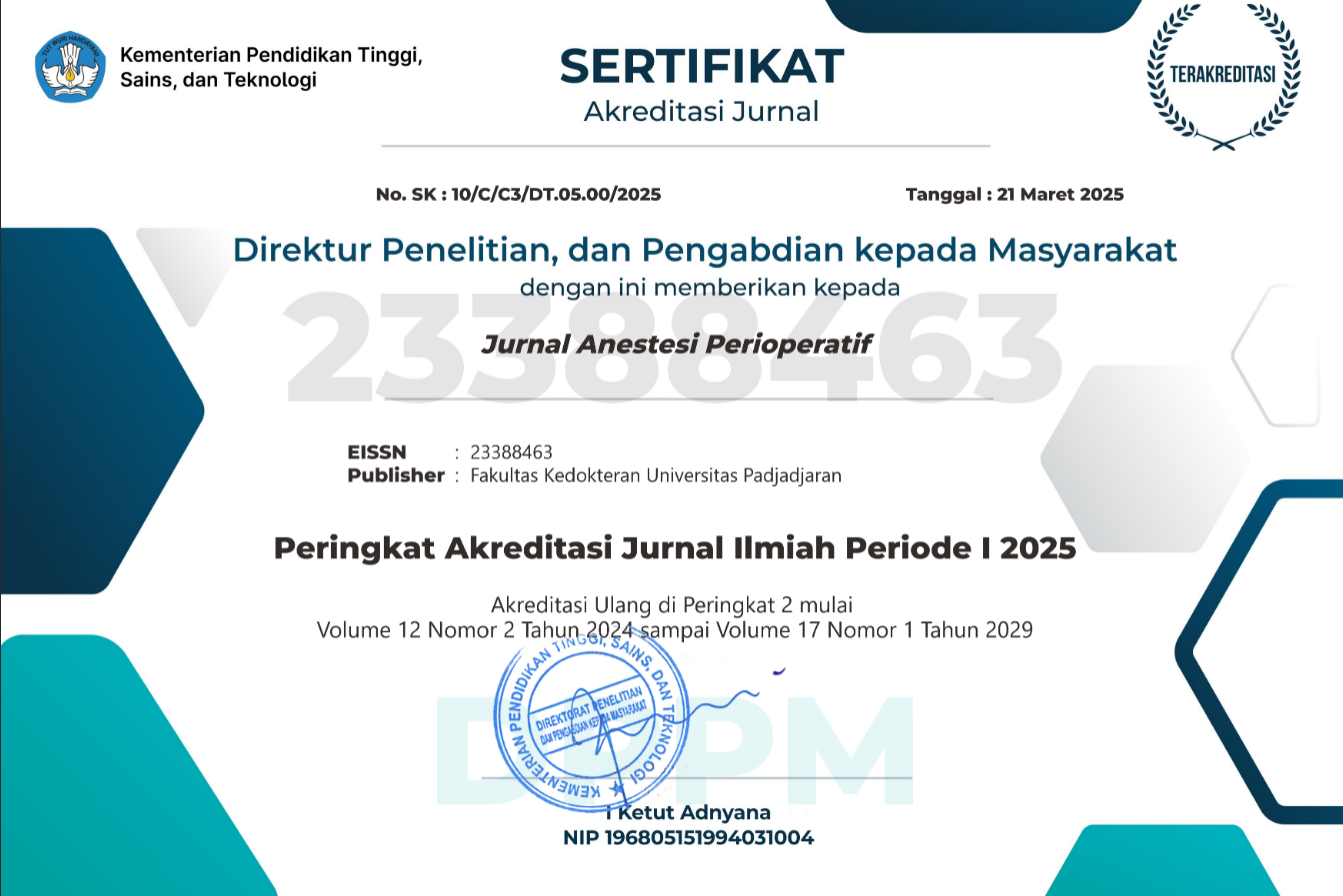Akupunktur pada Pasien dengan Efek Samping Obat Pascatindakan Anestesi Spinal
Abstract
Akupunktur secara luas telah digunakan untuk menginduksi analgesi. Akupunktur dapat digunakan sebagai terapi nyeri, alergi, inflamasi, gangguan metabolik, dan pascastrok. Laporan kasus ini bertujuan memaparkan manfaat akupunktur sebagai terapi gangguan akibat efek samping obat. Seorang wanita 59 tahun memiliki keluhan nyeri perut bagian bawah akibat kista ovarium terpuntir. Pasien alergi terhadap hampir seluruh obat yang pernah diminumnya termasuk antibiotik, analgetik, non steroidal anti inflamatory drugs (NSAID), steroid, dan vitamin. Pasien menjalani kistektomi dengan anestesi spinal menggunakan obat anestetik lokal bupivakain 10 mg di Rumah Sakit Dr. Dustira Cimahi pada 20 Juni 2016. Tiga puluh menit pascabedah pasien mengeluh nyeri di daerah operasi dan muncul efek samping obat dengan keluhan pusing, mual, muka terasa bengkak dan tebal, serta kulit kemerahan seluruh tubuh. Pasien diduga mengalami adverse drug reaction (ADR) akibat bupivakain. Pasien diberi tindakan elektroakupunktur dengan pemasangan jarum akupunktur pada titik insisi, Hegu (LI-4), Neikuan (P-6), Sanyinjiao (SP-6), dan Zusanli (S-36) bilateral dialiri listrik 10 mA pada frekuensi 40 Hz selama 30 menit. Setelah tindakan elektroakupunktur press needle ditempelkan pada titik Hegu sebelah kiri. Keluhan nyeri berangsur menghilang dan akibat efek samping obat tidak dirasakan lagi. Akupunktur dipilih untuk mengatasi nyeri pascaoperasi dan gangguan efek samping obat karena pasien memiliki riwayat alergi obat analgesik dan antialergi. Pada kasus ini akupunktur efektif mengatasi gangguan akibat efek samping obat anestetik lokal pada suntikan spinal.
Acupuncture on A Patient with Adverse Drug Reaction after Spinal Anesthesia
Acupuncture is widely used to induce analgesia. Acupuncture can be used in the treatment of pain, allergy, inflammation, metabolic disorders, and post-stroke. This case report aimed to describe the benefits of acupuncture as a therapy of adverse reactions to drug. A-59-year woman was presented weith a complaint of lower abdominal pain due to twisted ovarian cyst. She had a history of allergy to almost all drugs i.e. antibiotics, analgesics, non-steroidal anti-inflamatory drugs (NSAIDs), steroids, and vitamins. Patient underwent cystectomy under spinal anesthetic of 10 mg bupivacaine at Dr. Dustira Hospital Cimahi on June 20, 2016. Thirty minutes post-surgery, she started to complain about the pain in the area of the surgery and the signs-symptoms of allergic reactions occurred (dizziness, nausea, swollen and thick feeling of the face, and reddish skin all over the body). Patient was suspected of having adverse drug reactions (ADR) that was most likely the side effects of bupivacaine. She then received electroacupunture to address the postoperative pain and allergic reaction to bupivacaine. Acupuncture needles were placed at the point of incision consisting of Hegu (LI-4), Neikuan (P-6), Sanyinjiao (SP-6), and Zusanli (S-36) bilateral, electrified with 10 mA electricity with a frequency of 40 Hz for 30 minutes. After the electroacupunture was started, the press needle was placed on the left Hegu point. The pain and allergy complaints gradually disappeared. Acupuncture was chosen to treat postoperative pain and adverse drug reactions in this patient because she had a history of allergy to analgesic and anti-allergy drugs. In this particular case, acupuncture has successfully overcome the adverse reactions of local anesthetic drugs in spinal injections.
Keywords
Full Text:
PDFReferences
Ning Z, Lao L. Acupuncture for pain management in evidence-based medicine. J Acupuncture Meridian Studies. 2015;8(5):270–3.
Madsen MV, Gotzsche PC. Acupuncture treatment for pain: systematic review of randomised clinical trials with acupuncture, placebo acupuncture, and no acupuncture groups. BMJ. 2009;338(1):1–18.
Becker DE, Reed KL. Local anesthetics: review of pharmacological considerations. Anesth Prog. 2012;59(2):90–102.
Zijlstra FJ, Lange IB, Huygen FJ, Klein J. Anti-inflammatory actions of acupuncture, mediators of inflammation. Taylor Francis Health Sci. 2003;12(2):66.
Mucuk S, Baser M, Ozkan T. Effects of noninvasive electroacupuncture on labor pain, adrenocorticotropic hormone, and cortisol. Altern Ther Health Med. 2013;19(3):26–30.
Liu W, Yang X, Lie C. Adverse drug reactions to local anesthetics: a systematic review. Oral Surg Med. 2013;115(3):319–27.
Robertson J, David A. Low awareness of adverse drug reaction reporting systems: a consumer survey. Med J Aust. 2013; 199(10):684–6.
Lee J, Lee JY, Kim HJ, Seo KS. Dental anesthesia for patients with allergic reactions to lidocaine: two case reports. J Dent Anesth Pain Med. 2016;16(3):209–12.
Hu C, Zhang H, Wu W, Yu W, Li Y, Bai J, dkk. Acupuncture for pain management in cancer: a systematic review and meta-analysis. Evidence-Based Complementary Alternative Med. 2016;16(1):1–14.
Focks C. Atlas of acupuncture. Edisi ke-7. London: Churchill Livingstone; 2008.
Leung L. Neurophysiological basis of acupuncture-induced analgesia-an updated review. J Acu Meridian Studies. 2012;5(6):261–70.
Warner DS. Mechanisms of acupuncture–electroacupuncture on persistent pain. Anesthesiology 2014;120(1):482–503.
Gim GT, Lee JH, Park E, Sung YH, Kim CJ, Hwang WW, dkk. Electroacupuncture attenuates mechanical and warm allodynia through suppression of spinal glial activation in a rat model of neuropathic pain. Brain Res Bull. 2011;86(1):403–11.
Gheorghita E, Litarczek G, Trifu M, Rata O, Ciurea J, Gorgan RM. Anesthesia by electroacupuncture in neurosurgery. Romanian Neurosurg. 2010;3(1):348–53.
DOI: https://doi.org/10.15851/jap.v5n3.1165
Article Metrics
Abstract view : 7315 timesPDF - 6634 times
This Journal indexed by

JAP is licensed under a Creative Commons Attribution-NonCommercial 4.0 International License
View My Stats



